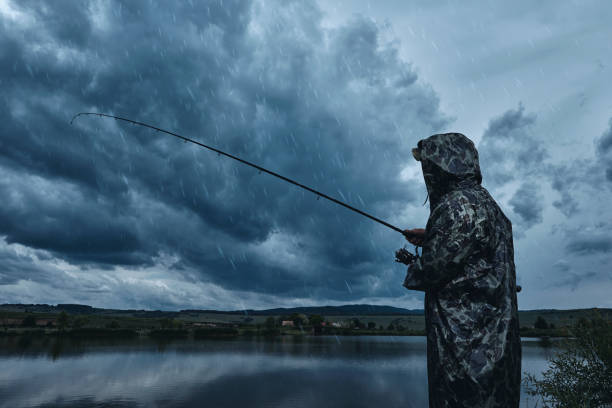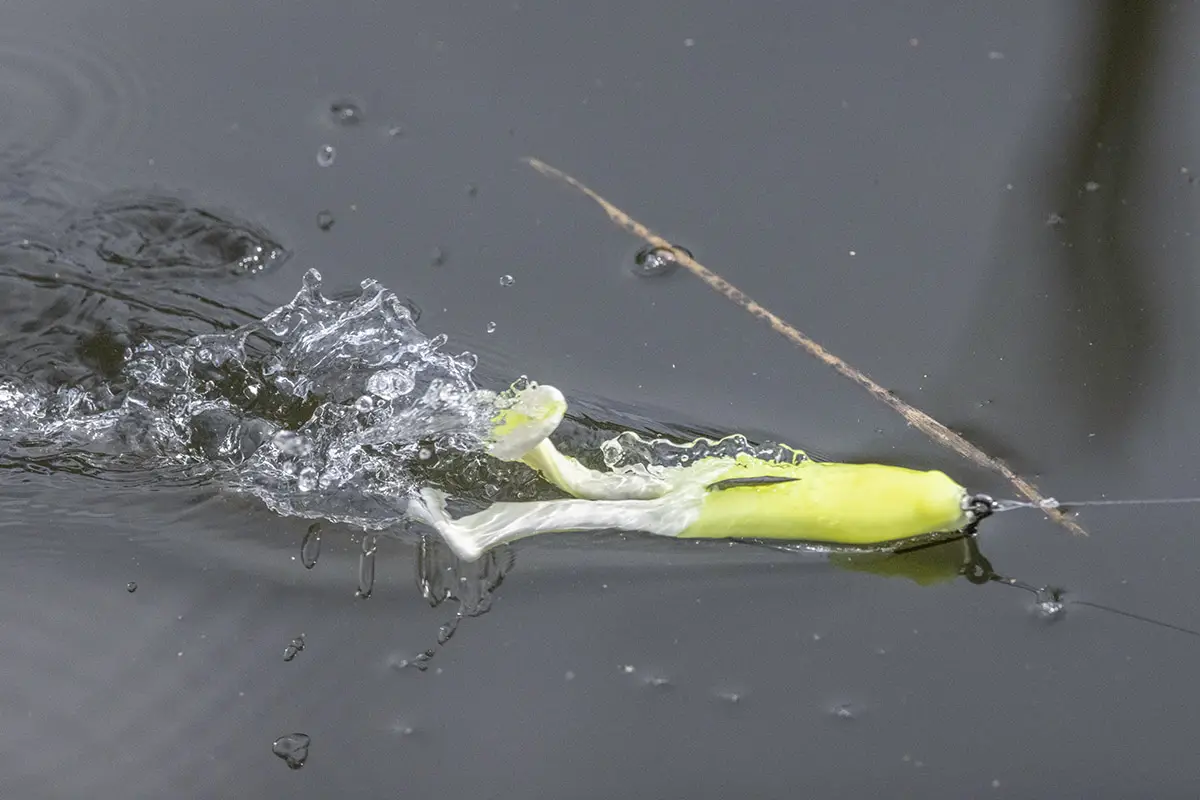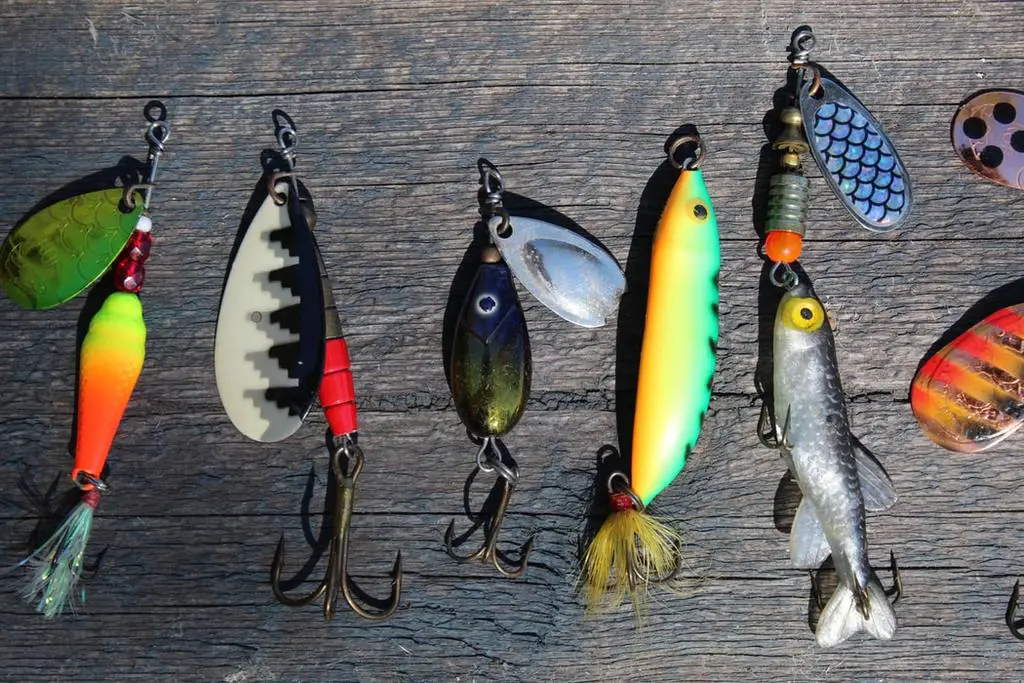When fishing for bass in the rain, target shallow areas and structure where bass seek shelter and ambush prey. Use moving baits like bladed spinnerbaits, crankbaits, or soft plastic swimbaits. Rain can make bass more active, so cover water methodically and adjust retrieval speed to entice strikes.
If you’re one of the many anglers that start to make their exit from the water when the rain moves in, you could be missing out on a unique time to catch bass. Bass fishing in the rain brings a host of new challenges as the barometric pressure falls, water becomes cloudy and incoming rain causes the temperature to drop.
Can you bass fish in the rain? Yes, but to maximize your efforts, you should keep some key things in mind.
This article is part of my Complete Guide to Bass Fishing series that you might be interested in.
| Technique | Situation | Effectiveness |
|---|---|---|
| Spinnerbaits | Shallow cover, around structure | ⭐⭐⭐⭐⭐ |
| Chatterbaits | Around submerged vegetation, grass lines | ⭐⭐⭐⭐⭐ |
| Topwater Poppers or Walking Baits | Surface action, targeting active bass | ⭐⭐⭐⭐ |
| Crankbaits | Bouncing off cover, such as rocks and wood | ⭐⭐⭐⭐ |
| Swimbaits | Targeting bass chasing baitfish | ⭐⭐⭐⭐⭐ |
| Jigs with Trailers | Flipping and pitching in heavy cover | ⭐⭐⭐⭐ |
| Soft Plastic Worms or Creature Baits | Texas-rigged around structure or vegetation | ⭐⭐⭐⭐⭐ |
Table of Contents
1. Barometric Pressure Explained
Checking the weather before any fishing trip should be standard protocol if you want to plan your trip and use specific techniques and strategies adequately. When you see rain in the forecast, you should expect the barometric pressure to change in a way that usually benefits bass anglers.
This is beneficial for fishing because the dropping pressure makes bass feel more lively and active. Imagine having a 45 pound weight on your shoulders all the time, then having it suddenly removed. This is somewhat similar to what bass feel when there is less pressure in the air thanks to an oncoming weather system.
The barometric pressure will usually drop steadily as a weather system approaches, then drop off right before the rain begins. During the few hours when the barometric pressure is falling or dropping is widely considered to be the best time for bass fishing. In contrast, when the pressure is rising, fish will be pushed deeper into the water and will hold very closely to cover, making them tough to catch.
The pressure will sometimes drop right before or during the onset of rain, so you should pay close attention to the barometric pressure and adjust your strategy accordingly. Once the front moves through and the rain ends, you can expect the pressure to begin rising once again, which is not an ideal time to be fishing.
Wind can also impact on bass behavior as it stirs up food and increases feeding activity. Personally I am pleased if the wind is up as long as it doesn't exceed 15-20 knots.

2. Using Search-and-Destroy Lures
When it’s raining and you want to truly take advantage of the conditions to catch hungry bass that are energized by the falling barometric pressure and other factors that come with rain, it’s best to use some of the ‘search-and-destroy style’ lures. These lures allow you to cover a great amount of water within a short period. Unlike lures and rigs such as Texas Rig, shaky head and other similar presentations, search-and-destroy lures are used with a steady retrieve instead of slowly working them back to your position.
Some of my favorite search-and-destroy lures include spinnerbaits, which allow me to adjust my presentation to target bass at various water column levels by letting the lure fall to the desired depth. Spinnerbaits seem to have a magical touch when fishing in the rain as bass will instinctively strike at almost anything that comes within range when experiencing this dropping-pressure burst of energy.
I always keep a white or white-and-chartreuse spinnerbait with double willow leaf blades on hand in case of a rain shower while on the water. Other lures that work exceptionally well for covering lots of water and drawing reaction strikes are chatterbaits, swimbaits and buzzbaits. If I’m fishing in heavy rain, I’ll break out a larger buzzbait equipped with a clicker or other mechanism to draw more attention to it.
The key to using search-and-destroy lures in the rain is to remember that bass are more active and you need to find where they are in terms of depth and cover.
3. Topwater Magic
If you’re fishing in the rain anytime from late spring to early fall, you can bank on topwater lures, which is the key to catching bass in good quantities and quality. Rain tends to wash a huge variety of insects, frogs, and other creatures into the water as it falls. When this happens, the bass will instinctively turn their attention upwards in hopes of picking off an unsuspecting frog or other type of prey that will be an easy meal.
It’s important to note that no topwater lure will work during the rain, especially when heavy rainfall is present on the lake. It’s best to stick with topwater lures that also fall into that search-and-destroy category, which you can use to cover more water in a shorter time. You can use a topwater lure when it’s raining regardless of what time of day it is.
My all-time favorite topwater lure for fishing in the rain is a buzzbait and there’s something about casting it around the banks of any lake when the rain is falling. A whopper plopper also works very well while it’s raining as you can usually retrieve it with relative speed and cover a sizable amount of water. You should refrain from using poppers and hollow-body lures such as mice or frogs as these are too slow and are meant to draw a bass’ attention when the surface is calm.

4. Spinning Blades are Key
When there’s rain in the forecast, you can expect overcast, gray skies above, which greatly influences the type of lures bass seem to prefer. As we’ve already noted, you can expect bass to turn their gaze upwards when the rain falls, so any lure you use should remain in the upper portion of the water column to produce the best results. Personally, I’ve found that any bladed lure works wonders when retrieved just below the surface.
This includes spinnerbaits, chatterbaits, rooster tails, inline spinners, road runners and even buzzbaits. A bladed lure running just below the surface will stand out to bass and will often appear to be a bait fish or minnow swimming along as the rain falls. The gray, overcast skies usually help certain bladed lures appear more natural and professional bass anglers often turn to a spinnerbait just below the surface once the rain falls.
One of the lures I love to use in a light rain is a buzzbait, but I retrieve it slightly slower so the buzz blades churn the water to a lesser degree. Using buzzbaits in this manner makes them almost feel like a spinnerbait, but there’s something about using this method that makes bass go crazy. According to many expert anglers, this technique seems to enrage bass and force them to strike out of instinct instead of necessity.

5. Focus on Banks and Runoffs
When the rain is falling at a moderate or heavy pace, you can expect to see certain drainage canals or ditches form small creeks in minutes. Bass are naturally attracted to any creek or stream running into a water body. These newly-created, yet temporary runoffs are often capable of attracting hungry bass.
The runoff brings in oxygenated water and a litany of other creatures like worms, insects, crawfish and many others that bass will eat. It’s in these areas where I might adjust my approach for bass fishing in the rain and I’ll use a Texas-rigged crawfish, finesse worms, or even a Ned rig thrown at the point where the runoff is entering the lake.
In addition to looking for runoffs, you should also be focusing your efforts around banks as bass will usually look for any type of creatures that might be washed into the lake due to the rain. Heavy rains can transform a lake and the way bass relate to their surroundings, so it’s crucial that you also acknowledge the need to adjust your bass fishing strategy for better results.
6. Rising Water Levels
When heavy rains fall in a short amount of time, there’s a small window of time you have to fish certain areas before the water becomes incredibly muddy. It’s not uncommon to have a lake level rise significantly in just a few hours due to steady rain and what you should look for is any new area where you can take your boat. Sections of the lake where the depth was just too shallow only a few hours or a day prior are now accessible to anglers and fish alike.
Bass will often venture into these types of areas looking for an easy meal and anglers can maximize their efforts by fishing them at just the right moment. If you know your lake well enough, you can keep certain portions in mind for occasions when the water level rises quickly. Many areas where a blowdown or brush pile was standing just on the edge of the water are now submerged and should be what you need to focus on first if you’re looking for a reaction strike.
7. Heavy Rains During the Spring
We know you’re likely to be aware that bass spawn during the spring and the heaviest rainfalls usually occur during mid-to-late spring once many bass have already spawned. You can target these sections by paying attention and marking certain parts of the lake where you know bass usually make beds and lay eggs.
When the water is rising, this opens up a once-shallow area and makes it vulnerable from all sides. Spawning bass will be on high-alert during steady rains and rising waters because this is when certain egg-stealing creatures will make their move. I like to throw a shaky head worm or Texas rig into the bedding area to probe for bass that are guarding their eggs or fry.
Expect the water to be a bit cloudy around the banks, so brighter colors will work best to get a bass’ attention when it’s on-guard against anything that might devour its young.
Conclusion
Bass fishing in the rain can be exhausting and exhilarating at the same time. If you want to take advantage of this rare opportunity to catch bass as the barometric pressure falls, always store some rain gear or a poncho in your boat or tackle box. If you’re willing to adjust your bass fishing strategy and use the information and tips described in this article, you’ll find that fishing in the rain can be extremely productive.
